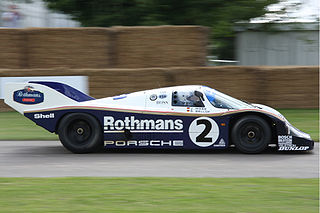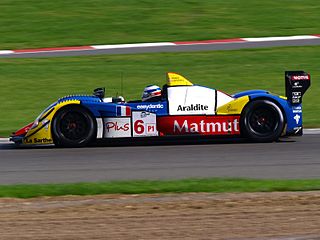
The Porsche 959 is a sports car manufactured by German automobile manufacturer Porsche from 1986 to 1993, first as a Group B rally car and later as a road legal production car designed to satisfy FIA homologation regulations requiring at least 200 units be produced.

The Porsche 961 was a racing car built by Porsche and based on their 959 sports car. It was intended for Group B sports car racing, complementing the purpose-built 956 and 962C which ran Group C in the World Sports-Prototype Championship. The 961 project was short-lived, running only three races and seeing the construction of only one car. Plans to sell the car to customers were scrapped when the Group B class was canceled.
The Ferrari P was a series of Italian sports prototype racing cars produced by Ferrari during the 1960s and early 1970s.

The Porsche 956 was a Group C sports-prototype racing car designed by Norbert Singer and built by Porsche in 1982 for the FIA World Sportscar Championship. It was later upgraded to the 956B in 1984. In 1983, driven by Stefan Bellof, this car established a record that would stand for 35 years, lapping the famed 20.832 km (12.93 mi) Nürburgring Nordschleife in 6:11.13 during qualifying for the 1000 km Sports Car race. The record was finally surpassed by Timo Bernhard in a derestricted Porsche 919 Evo on 29 June 2018.

Courage Compétition was a racing team and chassis constructor company now owned by Oreca, based in Le Mans, France near the Circuit de la Sarthe. It was founded by Yves Courage, a French race driver who ran hillclimbs before founding the company. Following the purchase of Courage by Oreca in 2007, Yves Courage has refounded the company as Courage Technology in 2010, attempting to develop electric racing cars.

The Peugeot 905 is a sports-prototype racing car built by Peugeot's racing department, Peugeot Talbot Sport.

Ray Mallock Ltd., also known as RML Group, is a motorsports and high performance engineering company, based in Wellingborough, Northamptonshire, United Kingdom.

The Acura ARX-01, later known as the HPD ARX-01 is a series of Le Mans Prototype built for sports car racing, specifically in the American Le Mans Series, Le Mans Series, and at the 24 Hours of Le Mans. It is the first purpose-built race car by the Acura division of Honda Motor Company, part of their multi-year program to eventually compete in endurance race. The car debuted in 2007 in the American Le mans Series before expanding to customers in Europe. Over the years various specifications of the ARX-01 chassis have been developed, each signified by a letter suffix. In 2010 Acura withdrew their name from the program and Honda Performance Development which developed the car for Acura continued the program into 2011.

The Courage C30, also known as the Courage C30LM, was a Group C2 sports prototype, designed, developed and built by French manufacturer Courage in 1993. It famously contested in the 1993 24 Hours of Le Mans, with drivers Derek Bell and Pierre Yver finishing in 10th and 11th place, respectively.

The Courage C34 was a sports car prototype, designed, developed and built by French manufacturer Courage in 1995. It famously contested the 1995 24 Hours of Le Mans, where it managed to finish 2nd overall in its class.
The Cougar C20 was a Group C sports car prototype used in sports car racing from 1987 to 1990.
The Cougar C22 was a Group C sports car prototype used in the World Sports-Prototype Championship sports car racing series, from 1988 to 1989.
The Cougar C24 was a Group C sports car prototype designed, developed, and built by French constructor Cougar, and used in the World Sports-Prototype Championship sports car racing series in 1990. Power came from a 3.0 L (180 cu in) Porsche 6-cylinder turbocharged engine. Its best result was a 7th-place finish at the 1990 24 Hours of Le Mans, being driven by Pascal Fabre, Michel Trollé, and Lionel Robert.

The Cougar C26S was a Group C sports car prototype built by Courage Compétition. It was used in the World Sports-Prototype Championship sports car racing series in 1991. Power came from a 3.0-liter Porsche 6-cylinder turbocharged engine. It achieved one podium finish; with its best results being a 2nd-place finish at the 1991 Most Interserie race, being driven by Frenchman Lionel Robert.

The Cougar C28 was a Group C sports car prototype build by Courage. It was used in the World Sports-Prototype Championship sports car racing series in 1992. Power came from a 3.0-liter Porsche 6-cylinder turbocharged engine. It managed to achieve an impressive 3 podium finishes and 1 class win. Highlights include an overall 6th-place finish at that year's prestigious 24 Hours of Le Mans, two third-place finishes and a sixth-place finish for Tomas Saldaña at the Interserie races in Jarama, Zeltweg, and Brands Hatch (respectively), and a third-place finish for Marco Brand at the Interserie race in Mugello.
The Cougar C12 was a Group C sports car prototype race car, designed, developed and built by French constructor Cougar in 1985, and used in sports car racing from 1985 to 1988. Its best result was an 18th-place finish at the 1986 24 Hours of Le Mans, being driven by Yves Courage, Alain de Cadenet, and Pierre-Henri Raphanel.
The Cougar C02 was a Group C sports car prototype race car, designed, developed, and built by French constructor Cougar in 1983, and used in sports car racing from 1983 to 1984. It was the successor the C01. Its best result was at the 1984 500 km of Watkins Glen, where drivers Yves Courage and John Jellinek, and Alain de Cadenet finished in 9th-place, respectively.

The Toyota 91C-V is a Group C sports prototype racing car, developed and built by Toyota intended to participate in the World Sportscar Championship, the 24 Hours of Le Mans, and the All-Japan Japanese Sports-Prototype Championship. It is an evolution of the previous 90C-V. Its powerplant is a turbocharged 3.2–3.6 L (200–220 cu in) Toyota V8 engine, producing 800 hp (600 kW). It won 3 races, achieved 6 podium finishes, and scored 3 pole positions. At a speed of 200 mph (320 km/h), it is capable of producing over 5,000 lbf (22,000 N) of downforce.
The Welter-Meunier P82, and its successors and derivatives, including the P83, the P83B, and the P86, are a series of mid-engined Group C sports prototype race cars, designed, developed and built by French racing team Welter Racing, for sports car racing, between 1982 and 1986. The cars best result was a 6th-place finish at the 1982 1000km of Monza, being driven by Roger Dorchy, Guy Fréquelin, and Jean-Daniel Raulet. It was powered by a Garrett twin-turbocharged, 2.7 L (160 cu in), Peugeot PRV, V6 engine, producing between 600–890 hp (450–660 kW) @ 8300 rpm, depending on boost pressure, which drove the rear wheels through a 5-speed manual transmission. The chassis design was constructed into an aluminum monocoque, and the car weighed approximately 900 kg (2,000 lb).

The Courage LC70 is a Le Mans prototype of the LMP1 class developed by Courage Competition and used in sports car racing since 2006. In the meantime, however, Courage Compétition has been taken over by ORECA, so the original name Courage LC70 has been changed. The Courage-ORECA LC75 is almost identical in construction but was designed for the LMP2 class. Other modifications of the LC75 are the Acura ARX-01a and Acura ARX-01b, which has been used in the American Le Mans Series since 2007. The type designation LC stands for Lillian Courage, the wife of Yves Courage who died in 2004.












